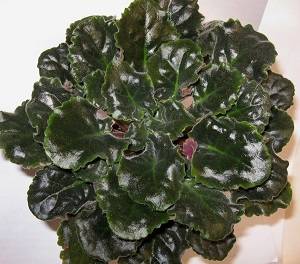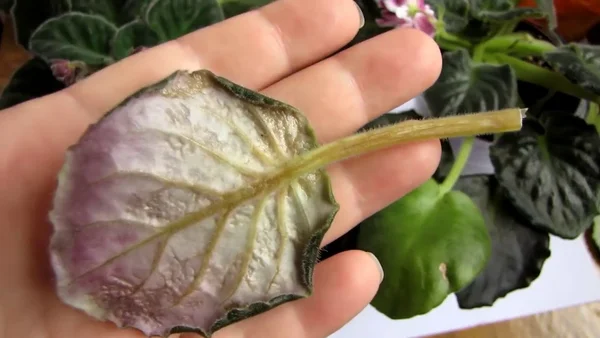Diseases and problems in violets can manifest themselves at an inopportune moment.
It would seem that the care was compiled correctly, the collection grows and blooms remarkably, but a couple of bushes behave suspiciously, as they started having African violet leaf problems and diseases.

African violet leaf diseases
African violet leaf Rot
The rot of leaf plates appears as a result of the attack of harmful insects or due to excessive watering.
To get rid of putrefactive bacteria, it is necessary to remove the rotten areas and treat the plant with a fungicide.
Violet leaves to rot.
Powdery mildew
It can be easily identified by the way it is sprinkled with a substance that resembles flour. With a small lesion, the flower can be saved by treating it with Topaz.
Fusarium wilt (yellowing or wilting of leaves)
Brown spots appear on the flower, which expands to cover the entire leaf area.
It is impossible to save the plant with this defeat. You can try to root individual parts, but the main mother bush must be thrown out along with the soil, and the pot must be rinsed with water and doused with boiling water.
Fusarium wilt.
IMPORTANT! The disease is easier to prevent than to cure a plant in distress.
African violet leaves hard
The main reason why violets have tough, fragile leaves is an excess of light. This usually occurs in the summer, which is rich in ultraviolet rays. The moment the violet rosette receives too much illumination, its leaves become fragile.
Rearranging such outlets in a darker part of the room can help.
african violet too many leaves and few flowers
If violets have many leaves and few flowers, this suggests that the grower is carried away by fertilizers that are inappropriate for the type of flower. That is, the proportion of nitrogen in the fertilizer exceeds everything else.
As you know, nitrogen parts contribute to an increase in the green mass of a plant due to the absence of flowering.
Or another option is possible the flower was originally planted in unsuitable soil, where there are a lot of nutrients with organic matter, which helps to grow foliage to the detriment of flowering.
To correct the situation, in the first case, any feeding is stopped, and in the second case, transplanting into the appropriate soil will help.
Few leaves
The main reason why violets have few leaves is a lack of nitrogen fertilizers and the flower clearly lacks lighting. It is necessary to feed the flower one-time with fertilizer for palms or focuses and put it in a brighter place.
IMPORTANT! You should not get carried away with fertilizers for ornamental deciduous plants, as you can get a huge bush without flowers.
Have problem Powdery Mildew On African Violets check out solution.
African violet leaf problems

African violet Twisting down?
This phenomenon has its own reasons, and the main one is excessive watering. Therefore, it is necessary to revise the irrigation regime and reduce it.
Most often, if the leaves curl, then there are problems with the roots and in this case, it is necessary to transplant the violet into new soil, since the one in the pot has deteriorated from waterlogging.
Usually, the leaves curl downward due to overflow.
Curling inward?
The most common cause may be too much water during irrigation. The flower grower needs to understand that in watering it is necessary to find a balance so that the plant does not suffer from overflows and from the drought that occurs in the absence of moisture. Watering needs to be adjusted.
The leaves can also be deformed if the outlet is overfed with fertilizers. In this case, feeding is stopped for a month or more, depending on how overfed the violet was.
If watering and feeding are at the proper level, it means that the flower has been attacked by a cyclamen tick. It cannot be seen without magnification and the bush should be treated with Fitoverm.
Curling up?
Twisting of the violet rosette leaves may occur due to improperly selected soil.
In this case, a full bush transplant is done, but at the same time, for safety reasons, you need to take a couple of leaves in order to root them in a separate container.
IMPORTANT! Purchased soil can suffer too much from drying out, and experienced growers add soil from the garden to it to make the substrate heavier.
Rotting?
Leaves can rot from over-watering. So with an excess of moisture, the roots rot and when they are completely affected, the rot passes to leaf cuttings.
Rot also occurs from the fungal disease fusarium.
Therefore, in order to avoid this disease, one must be careful about the organization of the irrigation regime.
Are they getting smaller?
Leaves become small for various reasons, they need to be considered and measures are taken at their discretion:
- violets love to “eat” and often the soil after a couple of years becomes unsuitable for the growth of the bush, and this requires transplantation;
- a transplant is required, since the root mass has completely filled all the soil in the pot;
- also the leaves become smaller when a small child is planted in a pot, taken strongly for growth. Transplant into a smaller container is required;
- bay plants;
- the presence of pests.
Leaves can become shallow for various reasons.
Wither?
Leaves lose their turgor for a number of reasons. This could be overflow or frequent dry spells. But after that, problems with the roots definitely begin, they either rot or dry out.
Therefore, you will need to re-root the outlet and the leaves taken from it. Before planting, they must be saturated with water, improving their turgor.
Climbed up?
If on the whole bush the leaf plates have risen up, then the first of the reasons can be called the fact that the outlet does not have enough lighting.
As a means to improve the environment, it is rearranged to a brighter place or illuminated with special lamps.
Also, from an excess of lighting, the leaves, trying to absorb as little light as possible, rise up.
IMPORTANT! Leaves raised upward can be a varietal feature of the plant.
Dry around the edges?
The plates dry from the edge when the room humidity is too low or the plant is standing in a cold draft.
First of all, it is rearranged in a place where there are no drafts. You can increase the humidity by placing cans of water around the bushes or turning on a humidifier.
The edges of the leaves can dry out due to insufficient air humidity.
Stained and discolored?
Any spots appearing on the vegetative mass indicate improper care of it. Therefore, it is necessary to reconsider what is being done wrong and correct the situation.
Also, spots can be a consequence of the waste product of insects. It is necessary to get rid of them by certain means, having previously removed the plant to the quarantine zone.
Check the guide on Why African Violet Leaves Drooping?
Conclusion
If various spots or other unhealthy signs appear on the plant, this suggests that the violet itself suggests that the wrong care has been organized for it. By revising it and finding mistakes, you can save the flower from inevitable death.